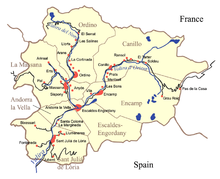Feixa del Moro necropolis
The necropolis of Feixa del Moro is located in Juberri in Andorra . The three stone boxes of the necropolis are so far the only Neolithic sites in the small Pyrenees state .
Feixa del Moro is located at an altitude of 1335 m near the village of Juberri and the border with Spain . The area was covered by terracing , which was abandoned, until the 1960s .
Xavier Llovera and Pere Canturri's excavations took place between 1983 and 1985. Three Neolithic stone boxes were discovered. The investigations using the radiocarbon method first dated them to the 3rd millennium BC. A review of the documentation, human remains, and artifacts began three decades later . Biochemical analyzes were carried out and new data were obtained for two of the three burials.
Steinkiste 1 was largely looted when it was discovered in 1983. Its rectangular architecture has been preserved. But the southern end is missing. The length is 1.3 m, with a width and height of 0.8 m. The ceiling plate is on. The contents obtained consisted of eight axes with no signs of use. Five were from serpentine and three from shale and chert ( Spanish Cornéenne ).
Stone box 2, which is about 5.0 m northeast, is 1.7 m long, 1.0 m wide and 0.8 m high. It consists of a dozen thin side panels, some doubles, on three sides and a single block on the north side that determines the width. She recovered the approximately 1.65 m tall skeleton of a 20 year old woman (based on the pelvic morphology). In addition to the skeleton, 56 variscite beads and stone and bone tools were found.
Stone box 3 is roughly rectangular with a weak apse to the south. It consists of eight side stones and contained two skeletons, one of which belonged to a 1.55 m tall adult woman and the other to a newborn baby. As in stone box 2, variscite beads and tools were found. Anthracological analyzes made it possible to reconstruct the environment of the place in the Neolithic. Feixa del Moro was located in a forest at the transition zone between the subalpine pine forest and the height of the Scots pine .
The variscite comes from the mines "Minas prehistóricas de Gavà-Can Tintorer" located 135 km further south (in Gavà - province of Barcelona). Other finds seem to come from Provence and the Alps .
The type of burial is comparable to Neolithic sites such as Solsonès and Berguedà in central Catalonia . However, the variety of items that accompany the skeletons is more likely to be found in southern France and on the Mediterranean coast .
context
The first megalithic systems in neighboring Catalonia emerged towards the end of the Neolithic (4400-3600 BC) in the area of Tavehrt. Their builders used small stone slabs, which is why the buildings are also known as premegalithic. These are stone boxes ( Spanish cista ) made of vertical plates placed in square or rectangular mounds. The excavation of some structures revealed that they were individual burials.
See also
literature
- Elisenda Vives Balmaña: La Feixa del Moro a Juberri anthropologia del Restes Neolítiques
Web links
- Description span. And picture
- https://issuu.com/regirarocs/docs/presentacio_rgr_iii_congrolmen.wordpress.com/tag/la-feixa-del-moro/ description span. and picture
Coordinates: 42 ° 26 ' N , 1 ° 30' E
